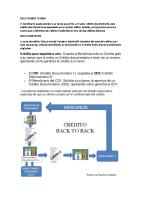Back Scratch
Back Scratch Test The Back Scratch Test, or simply the Scratch Test, measures how close the hands can be brought togethe
Views 135 Downloads 6 File size 175KB
Recommend stories
- Author / Uploaded
- physioali
Citation preview
Back Scratch Test The Back Scratch Test, or simply the Scratch Test, measures how close the hands can be brought together behind the back. This test is part of the Senior Fitness Test Protocol, and is designed to test the functional fitness of seniors. Another shoulder flexibility test designed for testing the elderly is the Shoulder Circumduction Test. purpose: This test measures general shoulder range of motion equipment required: ruler or a yardstick Procedure: This test is done in the standing position. Place one hand behind the head and back over the shoulder, and reach as far as possible down the middle of your back, your palm touching your body and the fingers directed downwards. Place the other arm behind your back, palm facing outward and fingers upward and reach up as far as possible attempting to touch or overlap the middle fingers of both hands. An assistant is required to direct the subject so that the fingers are aligned, and to measure the distance between the tips of the middle fingers. If the fingertips touch then the score is zero. If they do not touch, measure the distance between the finger tips (a negative score), if they overlap, measure by how much (a positive score). Practice two times, and then test two times. Stop the test if the subject experiences pain. Scoring: Record the best score to the nearest centimeter or 1/2 inch. Below is a table showing the recommended ranges (in inches) for this test based on age groups (from Jones & Rikli, 2002). Men’s Results
Women’s Results
Age
below average
average (inches)
above average
Age
below average
average (inches)
above average
60-64
> 6.5
6.5 to 0
3.0
3.0 to 1.5
< 1.5
65-69
> 7.5
7.5 to -1.0
< -1.0
65-69
> 3.5
3.5 to 1.5
< 1.5
70-74
> 8.0
8.0 to -1.0
< -1.0
70-74
> 4.0
4.0 to 1.0
< 1.0
75-79
> 9.0
9.0 to -2.0
< -2.0
75-79
> 5.0
5.0 to 0.5
< 0.5
80-84
> 9.5
9.5 to -2.0
< -2.0
80-84
> 5.5
5.5 to 0
10.0
10.0 to -3.0
< -3.0
85-89
> 7.0
7.0 to -1.0
< -1.0
90-94
> 10.5
10.5 to -4.0
< -4.0
90-94
> 8.0
8.0 to -1.0
< -1.0
Target population: the aged population which may not be able to do traditional fitness tests. Advantages: minimal equipment required. Other comments: The test is also sometimes called the Zipper Test, as the arm is placed down the back as if to pull up a zipper.
References: Anna Różańska-Kirschke, Piotr Kocur, Małgorzata Wilk, Piotr Dylewicz, The Fullerton Fitness Test as an index of fitness in the elderly, Medical Rehabilitation 2006; 10(2): 9-16. Jones C.J., Rikli R.E., Measuring functional fitness of older adults, The Journal on Active Aging, March April 2002, pp. 24–30.









